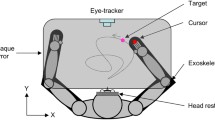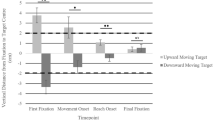Abstract
Visual information is vital for fast and accurate hand movements. It has been demonstrated that allowing free eye movements results in greater accuracy than when the eyes maintain centrally fixed. Three explanations as to why free gaze improves accuracy are: shifting gaze to a target allows visual feedback in guiding the hand to the target (feedback loop), shifting gaze generates ocular-proprioception which can be used to update a movement (feedback–feedforward), or efference copy could be used to direct hand movements (feedforward). In this experiment we used a double-step task and manipulated the utility of ocular-proprioceptive feedback from eye to head position by removing the second target during the saccade. We confirm the advantage of free gaze for sequential movements with a double-step pointing task and document eye–hand lead times of approximately 200 ms for both initial movements and secondary movements. The observation that participants move gaze well ahead of the current hand target dismisses foveal feedback as a major contribution. We argue for a feedforward model based on eye movement efference as the major factor in enabling accurate hand movements. The results with the double-step target task also suggest the need for some buffering of efference and ocular-proprioceptive signals to cope with the situation where the eye has moved to a location ahead of the current target for the hand movement. We estimate that this buffer period may range between 120 and 200 ms without significant impact on hand movement accuracy.



Similar content being viewed by others
References
Abrams RA, Meyer DE, Kornblum S (1990) Eye-hand coordination: oculomotor control in rapid aimed limb movements. J Exp Psychol Hum Percept Perform 16(2):248–267
Binsted G, Chua R, Helson WF, Elliott D (2001) Eye-hand coordination in goal-directed aiming. Hum Mov Sci 20:563–585
Carlton LG (1981) Processing visual feedback information for movement control. J Exp Psychol Hum Percept Perform 7(5):1019–1030
Cohen J (1992) A power primer. Psychol Bull 112(1):155–159
Desmurget M, Grafton S (2000) Forward modelling allows feedback control for fast reaching movements. Trends Cogn Sci 4(11):423–431
Elliott D, Roy EA, Goodman D, Carson RG, Chua R, Maraj BKV (1993) Asymmetries in the perception and control of manual aiming movements. Can J Exp Psychol 47(3):570–589
Fisk JD, Goodale MA (1985) The organisation of eye and limb movements during unrestricted reaching to targets in contralateral and ipsilateral visual space. Exp Brain Res 60:159–178
Georgopoulos AP (1995) Current issues in directional motor control, Trends Neurosci 18:506–510
Goodale MA, Pellision D, Prablanc C (1986) Large adjustments in visually guided reaching do not depend on vision of the hand perception of target displacement. Nature 320(4):748–750
Hayhoe M (2000) Vision using routines: a functional account of vision. Vis Cogn 7:43–64
Helson WF, Starkes JL, Elliott D, Beuekers BJ (1998) Manual asymmetries and saccade eye movements in right-handers during single and reciprocal aiming movements. Cortex 34(4):513–529
Johansson RS, Westling G, Backstrom A, Flanagan JR (2001) Eye-hand coordination in object manipulation. J Neurosci 21(17):6917–6932
Land MF, Furneaux S (1997) The knowledge base of the oculomotor system. Phil Trans R Soc Lond B Biol Sci 352:1231–1239
Land MF, Hayhoe M (2001) In what ways do eye movement contribute to everyday activities? Vision Res 41:3559–3565
Land MF, Mennie N, Rusted J (1999) The roles of vision and eye movements in the control of activities of daily life. Perception 28:1311–1328
Lee DN (1976) A theory of visual control of braking on information about time-to-collision. Perception 5:437–459
Lee DN, Georgopoulos AP, Clark MJO, Craig CM, Port NL (2001) Guiding contact by coupling the taus of gaps. Exp Brain Res 139:151–159
Miall RC, Jenkinson N (2005) Changes in human cerebellar activity patterns during learning of an eye-hand coordination task. Exp Brain Res 166:170–183
Miall RC, Reckess GZ (2002) The cerebellum and the timing of eye and hand tracking. Brain Cogn 48:212–226
Neggers SFW, Bekkering H (2000) Ocular gaze is anchored to the target of an ongoing pointing movement. J Neurophysiol 83:639–651
Neggers SFW, Bekkering H (2001) Gaze anchoring to a pointing target is present during the entire pointing movement and is driven by a non-visual signal. J Neurophysiol 86(2):961–970
Prablanc C, Eschallier JF, Komilis E, Jeannerod M (1979) Optimal response of eye and hand motor systems in pointing at a visual target. I. Spatio-temporal characteristics of eye and hand movements and their relationship when varying the amount of visual information. Biol Cybern 35:113–124
Sailer U, Eggert T, Ditterich J, Straube A (2000) Spatial and temporal aspects of eye-hand coordination across different tasks. Exp Brain Res 134:163–173
Tatler BW (2001) Characterising the visual buffer: real-world evidence for overwriting early in each fixation. Perception 30(8):993–1006
Woodworth RS (1899) The accuracy of voluntary movement. Psychol Rev 3:1–119
Acknowledgments
This report was prepared with support from the Economic and Social Research Council (RES-000-22-1266).
Author information
Authors and Affiliations
Corresponding author
Rights and permissions
About this article
Cite this article
Wilmut, K., Wann, J.P. & Brown, J.H. How active gaze informs the hand in sequential pointing movements. Exp Brain Res 175, 654–666 (2006). https://doi.org/10.1007/s00221-006-0580-x
Received:
Accepted:
Published:
Issue Date:
DOI: https://doi.org/10.1007/s00221-006-0580-x




